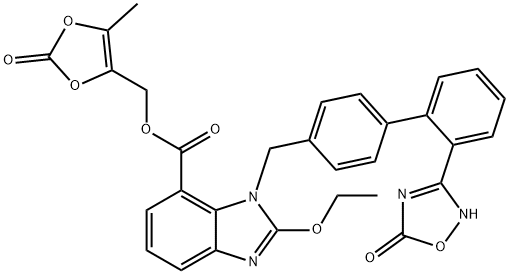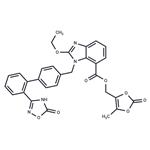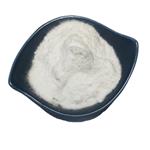Azilsartan medoxomil (Edarbi), an angiotensin II receptor antagonist,
was approved by the U.S. FDA in February 2011 for the treatment of
hypertension in adults. The discovery of azilsartan was the result
of a medicinal chemistry effort to identify an ARB with a different carboxylic
acid isostere than the ones found in the marketed ARBs. Several of the
marketed ARBs use a tetrazole group as a carboxylic acid isostere. The medicinal
chemistry approach that led to azilsartan involved the replacement of
this commonly used tetrazole with a 5-oxo-1,2,4-oxadiazole group.
Azilsartan can be synthesized by Suzuki coupling of p-tolyl boronic acid
to 2-bromobenzonitrile, followed by bromination of the methyl group.
The bromide is displaced to introduce a protected 2-ethoxy-1H-benzo[d]
imidazole-7-carboxylate. The cyano group is converted to a hydroxylamidine,
followed by reaction with an alkyl-chloroformate and intramolecular
cyclization to form the 5-oxo-1,2,4-oxadiazole ring. The acid is
then deprotected and converted to a prodrug. The parent, azilsartan has been
extensively characterized in vitro and compared with other marketed AT1
antagonists olmesartan, valsartan, telmisartan, irbesartan, and candesartan.
Azilsartan was found to be a potent (IC50=2.6 nM), selective, inverse agonist
of the AT1 receptor. From washout experiments, azilsartan was found
have slow dissociation from the receptor and thus is characterized as an insurmountable
antagonist.
Azilsartan medoxomil is a prodrug form of azilsartan , a potent and selective angiotensin II receptor 1 (AT1) antagonist. Azilsartan medoxomil (0.1-10 mg/kg) reduces blood pressure and decreases plasminogen activator inhibitor 1 (PAI-1) levels in the plasma, left ventricle, and aortic wall in mice in a dose-dependent manner. It also inhibits the pressor response induced by angiotensin II in normotensive rats (ID50 = 0.12 mg/kg) and reduces blood pressure and improves glucose infusion, a marker of insulin sensitivity, in spontaneously hypertensive rats. Azilsartan medoxomil also has more potent antiproteinuric effects in Wistar fatty rats than olmesartan medoxomil . Formulations containing azilsartan medoxomil have been used in the treatment of hypertension.
Azilsartan medoxomil is a long-acting angiotensin II receptor blocker (ARB) that is used to lower hypertension. When Azilsartan medoxomil enters the gastrointestinal tract, it is rapidly converted to its active form, Azilsartan (A926900).
ChEBI: A carboxylic ester obtained by formal condensation of the carboxy group of azilsartan with the hydroxy group of 4-(hydroxymethyl)-5-methyl-1,3-dioxol-2-one. A prodrug for azilsartan, it is used for treatment of hypertension.



